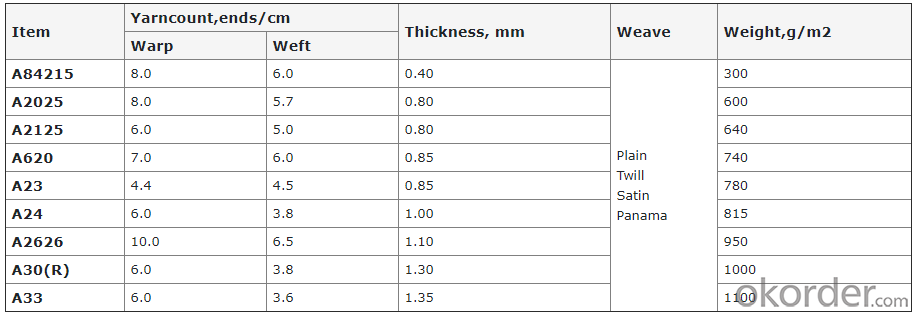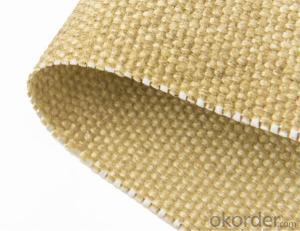Fireproof Fiberglass Cloth Coated With Vermiculite
- Loading Port:
- Ningbo
- Payment Terms:
- TT OR LC
- Min Order Qty:
- 500 m²
- Supply Capability:
- 300000 m²/month
OKorder Service Pledge
OKorder Financial Service
You Might Also Like
Description: Vermiculite coated fiberglass fabrics is mainly composed of alkali-free glass fiber and vermiculite, in which glass fiber is the substrate and vermiculite is the coating material. Vermiculite is a natural mineral. The vermiculite coating makes the composite glass fiber cloth resistant to high temperature in a short time to 1000℃ and continuous temperature resistance to 800℃.In the production process, the vermiculite is uniformly coated on the fiberglass products, and then dried in the subsequent process, the vermiculite settles on the fiberglass products, so as to produce coated vermiculite glass of different thicknesses and specifications Fiber products. At the same time, the glass fiber cloth has stronger fire breakdown resistance and friction resistance, and good mechanical processing performance.
Features: High Temperatures And Abrasion Resistant, Heat Protection
Application: high temperature gloves, high-temperature gaskets, and other high-temperature personal protective equipment, insulation blankets, welding blankets, welding pads, thermal protection, high temperature lagging, high temperature sealing, fire curtains, thermal insulation curtain, expansion joints

PRICE: USD7 per square meter
UNIT: square meter
MOQ: 500 square meters
Weight: 600gsm-3000gsm or customized
Width: 0.9m-2m or customized
Yarn Type: E-glass
Standing temperature: 850℃-1000℃
Product name: Vermiculite coated fiberglass fabric
Coating/Finish/Surface Treatment: Vermiculite coated
Roll length: 50 meter or customized
Color: Yellow
Weave Type: plain woven
Alkali content: Alkali free
Processing service: cutting
Material: fiberglass fabric, Vermiculite
Thickness: 0.6mm to 3mm
Size: can be customized
Supply ability: 300000 meters per month
Packaging: Vermiculite coated fiberglass fabrics rolls covered with film packed in cartons loaded on pallets or according to customers' requirements.
Lead time: 7-30 days
- Q:What are the different fiberglass fabric finishes for antistatic properties?
- Various fiberglass fabric finishes can be applied to provide antistatic properties. These finishes aim to reduce or eliminate the accumulation of static electricity on the fabric surface, which is crucial in industries like electronics, automotive, and aerospace. Some commonly utilized finishes include: 1. Carbon Coating: By applying a thin layer of carbon particles onto the fiberglass fabric, a conductive path is created, allowing swift dissipation of any static charge. 2. Conductive Polymer Coating: This finish involves applying a conductive polymer to the fabric, forming a continuous conductive network. The coating prevents static charges from accumulating and offers a high level of antistatic protection. 3. Metallic Coating: A thin layer of metal, typically silver or copper, is applied to the fiberglass fabric. The metal coating acts as a conductor, allowing static electricity to flow through and dissipate harmlessly. 4. Chemical Antistatic Finish: This finish entails applying a chemical treatment to the fabric surface. These treatments usually contain conductive agents that neutralize any static charge buildup. 5. Carbon Fiber Reinforcement: Carbon fibers can be woven into the fiberglass fabric to enhance its antistatic properties. Carbon fibers have inherent conductivity, effectively dissipating static charges. It is important to consider specific requirements when selecting a fiberglass fabric finish for antistatic properties. Factors such as the desired level of antistatic protection, durability, and intended use of the fabric will influence the choice of the appropriate finish.
- Q:Can fiberglass fabric be used for reinforcement in marine applications?
- Marine applications can benefit from the use of fiberglass fabric for reinforcement. This type of fabric is widely chosen for its ability to strengthen and reinforce various parts of boats and other marine structures. Its exceptional strength-to-weight ratio makes it an ideal material for enhancing the structural integrity of marine components. Boats commonly utilize fiberglass fabric to reinforce hulls, decks, bulkheads, and other sections. It is also widely employed in the manufacturing of sailboats, powerboats, yachts, and other watercraft. The fabric can be layered multiple times to provide additional strength and durability. One notable advantage of fiberglass fabric in marine applications is its resistance to water and corrosion. It does not absorb water, making it highly suitable for marine environments where exposure to moisture, saltwater, and other harsh conditions is common. Additionally, fiberglass fabric is resistant to UV radiation, which is crucial for preserving the structural integrity and appearance of marine components. Moreover, fiberglass fabric exhibits excellent dimensional stability, allowing it to retain its shape and strength over time. This attribute is particularly important in marine applications where boats and structures are subject to constant movement, vibrations, and varying loads. In conclusion, fiberglass fabric is a versatile and dependable material for reinforcing marine applications. Its high strength-to-weight ratio, resistance to water and corrosion, and exceptional dimensional stability make it a favored choice among boat builders and marine engineers.
- Q:Is fiberglass fabric resistant to chemicals used in food processing?
- Yes, fiberglass fabric is generally resistant to the chemicals used in food processing. It is designed to withstand a wide range of chemicals, making it suitable for use in various industries, including food processing.
- Q:What are the advantages of using fiberglass fabric in composites?
- There are several advantages of using fiberglass fabric in composites. Firstly, fiberglass fabric is lightweight, which makes it ideal for applications where weight reduction is important. Secondly, it has high tensile strength, meaning it can withstand high amounts of stress without breaking. Additionally, fiberglass fabric is highly resistant to corrosion, chemicals, and UV radiation, enhancing the durability and longevity of composite materials. Lastly, fiberglass fabric is relatively low in cost compared to other composite materials, making it a cost-effective choice for various industries.
- Q:How do you do fiberglass fabric on latex paint?
- Latex paint made of diatom mud, made of fiber cloth, did not try
- Q:Can fiberglass fabric be used for insulation in pipelines?
- Yes, fiberglass fabric can be used for insulation in pipelines. Fiberglass fabric is known for its excellent thermal insulation properties and is commonly used in various industrial applications, including pipeline insulation. It is an effective material for reducing heat loss or gain in pipelines and helps maintain the desired temperature of the transported fluid. Fiberglass fabric is lightweight, flexible, and easy to install, making it an ideal choice for insulating pipelines. Additionally, it is resistant to corrosion, moisture, and chemical exposure, ensuring long-term insulation performance.
- Q:Can fiberglass fabric be used for making bags or backpacks?
- Indeed, bags or backpacks can be crafted using fiberglass fabric. Renowned for its robustness, endurance, and tear resistance, fiberglass fabric is an ideal option for fashioning resilient bags and backpacks. Moreover, its lightweight nature renders it suitable for transporting goods without burdening the carrier. Furthermore, the malleability and versatility of fiberglass fabric enable the creation of diverse shapes and designs, allowing for personalized and adaptable bag and backpack construction. Nevertheless, it is crucial to acknowledge that fiberglass fabric lacks the pliability and softness of traditional fabric, thus potentially rendering it unsuitable for crafting bags or backpacks that necessitate a specific degree of flexibility or softness.
- Q:Can fiberglass fabric be used for making insulation boards or panels?
- Fiberglass fabric, a versatile material with excellent thermal properties, can indeed be utilized in the production of insulation boards or panels. Composed of finely woven glass fibers, this fabric boasts robustness and durability. Its incorporation into insulation boards or panels effectively traps air and impedes heat transfer, ensuring optimal insulation. Moreover, its lightweight nature, ease of handling, and moisture resistance make it an appropriate choice for a myriad of applications necessitating insulation, including buildings, industrial equipment, and automotive components. In conclusion, fiberglass fabric stands as a dependable and efficient option for the creation of insulation boards or panels.
- Q:Home improvement how to do waterproof acceptance?
- General engineering only sampling experiments on the watering pipe root, root protruding part of the chimney roof flashing, the number of extraction is a projecting roof flashing 1/3, watering not less than one hour, no leakage. If it is found that seepage and leakage, double the number of tests to be carried out, and then leakage parts, should be carried out all watering test
- Q:How is fiberglass fabric used in the production of insulation sheets?
- Due to its superior thermal insulation properties, fiberglass fabric is commonly utilized in the manufacturing of insulation sheets. This fabric is created by intricately weaving fine strands of fiberglass together, resulting in a robust and enduring material. In the production process of insulation sheets, fiberglass fabric is typically employed as a reinforcement layer. Initially, a layer of fiberglass fabric is placed atop the insulation material, which is typically composed of foam or mineral wool. This fabric serves to bolster the strength of the insulation sheet and prevent any tearing or damage during installation or usage. Moreover, fiberglass fabric functions as a barrier, preventing the insulation material from shifting or settling over time. This ensures the insulation remains intact, without any gaps or voids, thereby preserving its efficacy and efficiency. Furthermore, fiberglass fabric imparts additional fire resistance to the insulation sheets. It possesses inherent fire-resistant properties, which effectively curtail the propagation of flames and diminishes the risk of fire hazards. This is particularly crucial in scenarios where insulation sheets are employed in buildings or structures where fire safety is a paramount concern. Additionally, fiberglass fabric boasts excellent moisture resistance. It creates a formidable barrier against water or moisture infiltration, safeguarding the insulation material. This is of paramount importance in upholding the thermal performance of the insulation, as moisture can significantly undermine its effectiveness. In summary, fiberglass fabric plays a pivotal role in the production of insulation sheets by enhancing strength, providing fire resistance, improving moisture resistance, and ensuring long-lasting thermal insulation. Its versatility renders it a dependable and extensively utilized material within the insulation industry.
1. Manufacturer Overview |
|
|---|---|
| Location | |
| Year Established | |
| Annual Output Value | |
| Main Markets | |
| Company Certifications | |
2. Manufacturer Certificates |
|
|---|---|
| a) Certification Name | |
| Range | |
| Reference | |
| Validity Period | |
3. Manufacturer Capability |
|
|---|---|
| a)Trade Capacity | |
| Nearest Port | |
| Export Percentage | |
| No.of Employees in Trade Department | |
| Language Spoken: | |
| b)Factory Information | |
| Factory Size: | |
| No. of Production Lines | |
| Contract Manufacturing | |
| Product Price Range | |
Send your message to us
Fireproof Fiberglass Cloth Coated With Vermiculite
- Loading Port:
- Ningbo
- Payment Terms:
- TT OR LC
- Min Order Qty:
- 500 m²
- Supply Capability:
- 300000 m²/month
OKorder Service Pledge
OKorder Financial Service
Similar products
New products
Hot products
Related keywords




























